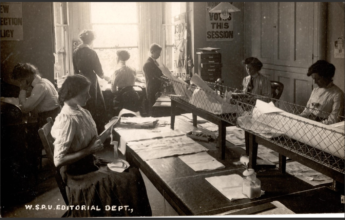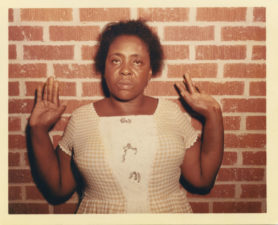Body theorising gripped women’s studies for a time in the 1980s and 1990s. Books were written, papers delivered at conferences, newspaper columns and columnists pronounced upon the subject, theses were proposed and completed, PhDs were awarded, and the topic gripped – or seemed to grip – an entire generation of academics. Then, as is so often wont, the topic drifted into abyance.
The body has in past and present held centre stage in more than the academic sense. During the decades and more of the Inquisition, the body – particularly woman’s body – was central to sin. Kramer and Sprenger’s Malleus Malificarum – ‘The Hammer [or Anvil] of Witches’ determined that women’s bodies should not be covered in gorgeous draperies, fine costuming or jewellery. Yet covered should they be – particularly the hair, which was demonised as a source of vanity, pride, evil and error. Still, modestly dressed women were not safe, being destined to die along with their more worldly sisters, for the body was the problem for witch-finders (so called) and no covering could protect a targetted woman from the prickings of Kramer, Sprenger and their colleagues, including the English jurist Matthew Hale who not only sat on trials of witches, declaring witchcraft to be ‘real’ and so to be subject to the criminal law, but pronounced upon women’s perfidy in other regards, particularly in the field of sexual abuse and exploitation.
Centuries later, Zadie Smith’s On Beauty played with the ‘body’ theme in fiction, whilst a century before, the body in all its constituent parts – along with beauty – was both a subject for sniggering sentiment, with ‘naughty’ postcards being sold surreptitiously on street corners and in alleyways or at fun fairs and in seaside pavillions, as well as a serious topic ‘for the ladies’.
Beauty , what it is and how to Retain it, published in London, Sept., 1873 by Frederick Warne & Co, led the way, along with its companion volume, How to Dress on £15 a Year.
Written by ‘A Lady’, readers learned that beauty, being ‘one of the great powers of the world’ necessarily found its way into discussion ‘by the philosphers and poets of all ages’, so that writing about it in the latter half of the nineteenth century created difficulty. ‘A Lady’ was, nonetheless, up to the task.
No longer was the body to be treated ‘by all wise people’ with ‘contemptuous indifference’. Nor was it any longer to be considered ‘a sinful vanity’ to dwell in thought on ‘personal beauty’. Leaving Kramer and Sprenger in the darkness of history, ‘A Lady’ pronounced Christianity – no less – to have, in its fresh ‘muscularity’:
‘… restored to the human frame that due regard with all men owe to it; and the new and more artistic sense of beauty which undoubtedly sprang from the great Exhibition of 1851, has rendered people more inclined to discuss beauty as an important and valuable gift, which, like all other good gifts of Heaven, requires and deserves our careful attention.’
A Lady had firm ideas about what constitutes beauty. Albeit citing writers, philosphers, playwrights and poets from Aristotle to Plautus to Shakespeare, Longepierre, Byron, Spenser and Drayton, and observing that England ‘has been justly styled the land of beauty’, she deplored the failure of English women to take steps to ‘improve or preserve their beauty’. This, it is, that she sets out to remedy.
A ‘gently serpentine’ body is that for which we ought to strive. Affirmation for this standard is found in the words of Leigh Hunt, asserting just this, for stiffness ‘is utterly ungraceful’. Women should emulate the movements ‘of an unconscious child’ for these are ‘the perfection of grace; they are easy, unstudied, natural’.
As to figure, the waist and throat should be synchronised in their measurements, for the waist should be ‘twice the size of this tower of ivory’, the throat, which ‘should be round, full, and pillar-like’. Shoulders ‘should be falling, and not too broad’ for very broad shoulders are a sign of masculine, not feminine, beauty. Nonetheless, shoulders ‘had better be broad than too narrow’. Why? For ‘any contraction across the chest gives a mean and pinched look to the person’.
Abjuring the exhortations that found support in the ante bellum south of the United States – as evidenced so well in Margaret Mitchell’s Gone with the Wind and in the visual representations displayed in Victor Fleming’s film (who can forget the scene of Vivienne Leigh as Scarlet being laced into her stays, clasping the bedpost whilst Hattie McDaniel tugs and pulls the strings tight, tightly, tighter …), A Lady contends sharply that twenty-seven inches is the signal waist ‘beauty’:
‘The figure should be easy; too small a waist is an actual deformity, and we may remind young ladies who labour under the delusion of thinking that a waist of eighteen inches is lovely, that that of the Venus de’ Medici, the acknowledged type of female beauty, measures twenty-seven inches.’
What is extraordinary about Beauty … , at least in present times when the bosom, bust or breasts are such a feature in the panoply of every plastic surgeon’s list of ‘to dos’ or, rather, ‘must dos’, is that this part of the body is entirely left out of the recitation of ‘form’. It is also instructive to observe the vast difference between then and now: perusing Beauty is a reminder that what is now known as ‘the beauty industry’ has existed for centuries, yet today’s manifestation of it is no improvement on the past and the resort to surgery that appears to be an everyday requirement was generally absent from 19th century recitations of what women were obliged to do to be ‘real’ women.
Chinese footbinding and other cultural attacks on women’s bodies – including the Inquisition, neck-stretching and female genital mutilation (FGM), along with 19th century psychiatric ‘cures’ including clitoredectomy and rhinoplasty – find no place in Beauty … Rather, A Lady concentrates upon posture, diet and ungents for the face and neck. Yet just as the ‘surgical’ changes to women’s bodies caused and cause serious damage, so too the pastes and creams applied. This is graphically described in Barbara Ewing’s Fraud one of the major protagonists ultimately suffers serious skin damage and facial disintegration from applying paste to whiten her complexion.
The field is rich with so many graphic indicators of the way that women’s bodies have ever been, and remain, sites for and of struggle. Women’s independence, autonomy, sense of self and wellbeing are located not only in the mind, but equally so in the body. For women it is clear that the purported disjunction between mind and body is fallacious. Wilhelm Fliess, longtime colleague and friend of Sigmund Freud, drew upon this fundamental connection in his work, a tale of horrors, a recitation of the way in which acts that would be classed as torture in other circumstances can be meted out upon women in the name of ‘cure’.
Beauty … reminds us that homilies such as ‘her face is her fortune’ and ‘no ugly women need apply’ have a resonance in the lives of women and the demands women face in everyday life whether in centuries past or present.
Jocelynne A. Scutt (c) January 2013
Jocelynne Scutt’s films include ‘Covered’ – A DVD Installation in 3 streams – ‘Debating the Scarf’, ‘Romancing the Veil’ and ‘Contradictions of Cover’, ‘A Greenshell Necklace’ (with Karen Buczynski-Lee), and ‘The Incredible Woman’ (with Karen Buczynski-Lee). She is currently researching the field of women’s bodies, women’s ‘beauty’ treatments’, and medical negligence in the field of body ‘enhancement’.

